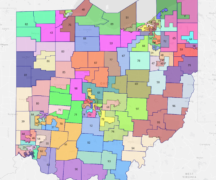BY SUSAN TEBBEN
At Tuesday’s meeting of the Ohio Redistricting Commission, rules were adopted and a map was proposed. But the process is far from over.
The map was submitted by the Ohio Senate Democratic Caucus, and commission co-chair state Sen. Vernon Sykes, D-Akron, said the map was drawn without outside input and without vetting. He said the map was put forth “to indicate that maps can be presented” in the time allotted to the commission. The Republican majority on the commission had not presented any proposed map from either the House or Senate GOP caucuses as of Tuesday evening, and nor had the House Democratic caucus or the commission itself, with a deadline hitting today, Wednesday Sept. 1.

“This is a starting point, and the members of the Senate Democratic Caucus urge the members of the commission and the public to provide feedback and suggestions,” Sykes said.
Randall Routt, policy advisor for the Senate Dems, presented the maps, saying the map “does not illegally split a single contiguous municipality or township in any district in the state.”
“In short, our General Assembly districts should roughly match the way Ohio voters have indicated their preferences over the past decade,” Routt said.
The ratio on the maps after using voter data over the last decade lands at a 45.9% Democratic and 54.1% Republican voter split.
The Senate Dems map should be made available for a review, along with maps that were submitted by the public last week, on the ORC’s website.
After a ballot initiative changed the way in which redistricting was going to occur, a deadline of September 1 was set for the proposal of legislative maps by the commission, a deadline that is clearly going to pass without an official map proposal.

Multiple times during Tuesday’s meeting, House Minority Leader Emilia Strong Sykes, D-Akron, asked for a plan from the co-chairs on presenting a map and allowing public input.
“I am not aware of such activity and have not been contacted about the data that you are looking at or considering in these maps,” Emilia Sykes said.
A public records request provided by Leader Sykes’ office to the OCJ show letters sent to Senate President Matt Huffman as early as May 4 to ask for an extension on the redistricting timeline from the Ohio Supreme Court, and to Gov. Mike DeWine as early as June 10 urging him to convene the ORC and call its first meeting.
The first meeting was convened Aug. 6.
Commission co-chair and House Speaker Bob Cupp, R-Lima, said because of the census data delay, the commission was delayed in beginning the process of map-making, but said the process is ongoing. He is still hoping for a bipartisan 10-year map, he said.
“A map is being developed carefully with regard to the data and the constitutional requirements,” Cupp said. “It is unlikely to be available before Sept. 1.”
But Cupp also said “the commission itself is not drawing a map, but we would expect maps to be presented to us for the commission’s consideration such as the (Senate Dems’) map that was presented here today.”
Asked who is working on maps in the caucuses, Cupp said “members of our internal staff” are working on it, and co-chair Sykes said “staff and consultants” in the Democratic caucus.
Commission member and Senate President Matt Huffman said he expects there to be four separate “caucus legislative maps,” two each from House parties and Senate parties, and multiple maps presented by the public before the final map is formulated.
“We look forward to those other presentations and then ultimately for the one introduction that the constitution calls for,” Huffman said.
Since the GOP is in the majority both in the General Assembly and in the redistricting commission itself, they have received accusations of keeping the mapmaking process a secret and using tightening timelines to make the process lean more toward a partisan 4-year map, rather than a bipartisan 10-year map.
Cupp, along with the other Republican members of the commission have all denied that the process is happening illegally or even improperly.
Katy Shanahan state director for the Ohio chapter of redistricting advocacy group All On the Line, said it’s clear the map-drawing has begun in earnest, but it’s too soon to see if public input will have an impact on the process.
“It’s also hard to tell what level of impact those public comments or proposed maps will have on this process because there’s so little transparency about what work they’re doing and when we will have additional hearings to give them feedback,” Shanahan said.
Having been a part of redistricting efforts in the past and an advocate for the process now, the former chair of the Ohio Democratic Party, David Pepper, said the process looks very familiar.
“When you look at how they’ve (Republicans) have been operating, it looks the same as last time,” Pepper said, referring to the 2011 process, which saw the Republican majority and staff drawing maps privately in a hotel room.
Republican member of the commission slammed Pepper for questioning whether they or their staffs have been discussing redistricting maps behind closed doors. Pepper has pointed to staff working on the process in private as substantiation for the secretive process he has alleged.
Cupp said the commission would be setting the schedule for three future public hearings and map proposals “very soon,” with an eye toward the “absolute deadline” of Sept. 15, as laid out in the constitution.
***
Also from Ohio Capital Journal:
Ohio colleges get funding boosts for security; Controlling Board approves contract to continue sexual violence initiative
Through recently announced grant funding and boosts from the Ohio Controlling Board, higher education across the state will be able to conduct security improvement projects, and continue an initiative regarding sexual violence on campuses.
The controlling board approved several funding requests for state colleges and universities, but they also approved a request from the Ohio Department of Higher Education to fund a third-party contract for a “changing campus culture campus climate survey,” according to documentation sent to the board.
The survey, which would be conducted through Hudson-based SMW Consulting, LLC., would be used to “provide campuses with the best information regarding the effectiveness and comprehension of college/university prevention and response trainings, readiness level for prevention programming, understanding of community beliefs and prevalence of different types of sexual violence,” the agency said in their request to the controlling board.
The Department of Higher Ed said the survey would be part of an initiative started in 2016, and in response to a report that called for Ohio colleges to use data to guide action, empower staff and students, communicate a culture of “shared respect and responsibility,” develop response protocol and adopt a “survivor-centered response” to prevent and better response to sexual violence incidents. READ MORE
U.S. military has left Afghanistan; evacuation of Americans and Afghans moves into next phase
WASHINGTON — Even as the last military planes left Kabul, members of Congress were still trying to facilitate the evacuations of more Americans and Afghans.
Reps. Jason Crow (D-Co.), Andy Kim (D-N.J.) and Tom Malinowski (D-N.J.) are leading efforts to supply names and contacts of Afghans who helped the U.S. in the last 20 years to the State Department to quickly process evacuations.
“We must protect our people and our friends by continuing evacuations from Kabul airport until the job is done,” Crow wrote on Twitter, adding that “the situation in Kabul is still life or death for American citizens and our Afghan partners.”
The U.S. completed its withdrawal from Afghanistan late Monday afternoon, ending a 20-year occupation, according to U.S. Marine Corps general Kenneth Franklin McKenzie Jr. READ MORE
Medicaid vaccination rates founder as states struggle to immunize their poorest residents
Medicaid enrollees are getting vaccinated against COVID-19 at far lower rates than the general population as states search for the best strategies to improve access to the shots and persuade those who remain hesitant.
Efforts by state Medicaid agencies and the private health plans that most states pay to cover their low-income residents has been scattershot and hampered by a lack of access to state data about which members are immunized. The problems reflect the decentralized nature of the health program, funded largely by the federal government but managed by the states.
It also points to the difficulty in getting the message to Medicaid populations about the importance of the COVID vaccines and challenges they face getting care.
“These are some of the hardest-to-reach populations and those often last in line for medical care,” said Craig Kennedy, CEO of Medicaid Health Plans of America, a trade group. Medicaid enrollees often face hurdles accessing vaccines, including worries about taking time off work or finding transportation, he said. READ MORE





